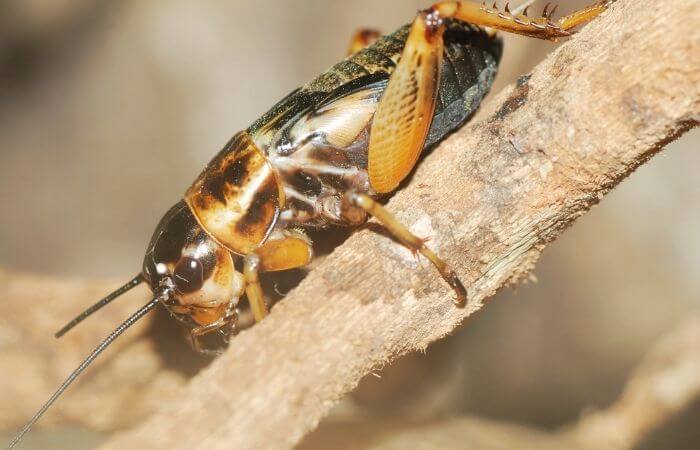The ambient background noise of chirping crickets can be soothing on a warm summer evening as you relax on the veranda.
However, if you are not used to cricket noise or you are a light sleeper then their chirping noise can be the exact opposite of soothing when you are trying to get to sleep at night.
While you can use traps to get rid of crickets, they are attracted by food, light and shelter so removing these is a more effective long-term method of dealing with your cricket problem.

Here are 8 ways to get rid of cricket noise so that you can get a peaceful nights sleep without having to call an emergency pest control company:
1. Tidy Up Your Garden / Yard
During the day crickets stay out of the way of predators by hiding in dark spaces such as:
- Under rocks
- In piles of leafs
- Logs
- Under plant pots
- Under the bark of a tree
- Under Decking
- Inside cracks in brickwork/concrete
- Small burrows in the ground
- …any dark moist space
During the night crickets enjoy grassland.
Keep your grass nice and short around your home, regularly mowing your lawn will make crickets less willing to get close to your home as it won’t feel as safe due to the lack of cover.
Move clutter away from your home.
If you have piles of logs, rocks dotted around, plant pots, and anything in the list above which may trap moisture and create a dark hiding place for a cricket then move it away from your home to the perimeter of your garden.
If possible get rid of any unnecessary objects altogether to minimize possible cricket hiding places.

Sweep up leaves and dispose of them as crickets love both eating decomposing leaves and also sheltering under them.
Also check your property for any cracks in walls, flooring or concrete, if you find any get them sealed up as crickets love to burrow into small holes.
2. Trap Them
If you know where the cricket noise is coming from then laying a cricket trap is an easy way of catching them.
- 4 Pack Value Pack (16 Total Traps)
- Non-poisonous attractant scent attracts crickets and spiders
- Features an adhesive specifically developed to remain effective in a variety of temperatures, including cold temperatures where other brands stiffen
Cricket and spider traps like the one above work by being very sticky, when a cricket steps onto it they will get stuck and be unable to leave it.
You can make the trap work better by enticing them towards it with food.
Crickets are omnivorous but they mostly eat rotting plant matter, when it’s available they also particularly enjoy fungi and fruit.
Strangely crickets also enjoy eating cardboard, the texture of damp cardboard closely resembles that of rotting plant matter. Another thing that is particularly irresistible to most insects, including crickets, is honey.
Trickling a spoonful or two of honey on and around some cardboard and then leaving this on your cricket trap to entice them to step on it is a sure-fire way to capture more crickets.
3. Vinegar & Salt
Vinegar and salt are lethal to crickets and will quickly kill them.
To use vinegar to get rid of crickets follow these steps:
- Mix vinegar into water at a ratio of around 4oz per quart (roughly 110ml per liter).
- Fill a spray bottle with the mixture.
- Spray liberally in and around the area where the chirping sounds are coming from.
This method will kill most crickets within a minute of contact with the vinegar.
If you don’t have any vinegar available you can also use salt water, salt water is slightly less effective than vinegar so you should increase the ratio of salt to water to 6oz per quart or roughly 170ml per liter.
Lemon juice can also work well, mix it at a ratio of 4oz per quart (roughly 110ml per liter) and repeat the process above.
4. Scents
Like many insects, crickets hate essential oils.

This is why essential oils are routinely used as natural pesticides.
Use thyme, sage or rosemary based essential oils for the best effect.
Spray them in any area where you suspect crickets may be located to deter them and ward them off.
Other smells that crickets hate include peppermint, lemon and cinnamon so spread these liberally around your yard if you don’t have any essential oils available.
5. Encourage Cricket Predators Into Your Garden
There are plenty of creatures that enjoy feasting on Crickets.
Introducing some new predatory pets to your garden is a guaranteed way of reducing cricket numbers.
1. Birds
Crickets are a perfect snack for a bird.
Encourage birds to make your garden their home by allowing hedges and trees to grow, installing bird feeding tables and fitting nest boxes.
Birds will be attracted to your garden once they realize that it is teeming with delicious nutritious crickets, so it won’t be long before there are not many left at all.
2. Frogs
Frogs love eating crickets, if you’ve ever owned a pet frog you will be familiar with the bags of crickets that pet shops routinely sell as part of your frog’s diet.
Crickets provide a filling protein-rich snack for a frog, installing a pond in your garden and encouraging frogs to live there is one of the most effective solutions to a persistent cricket noise problem.
Of course, it will take time to dig a pond and populate it with frogs so this is by no means a quick solution however if you have an enduring problem with crickets then cultivating a nice frog habit is a great long term strategy.
3. Cats
Cats are generally quiet pets who love hunting for fun, even though crickets aren’t something they would generally eat they will certainly be happy to hunt and kill a cricket for their own entertainment.

Once your cat works out that the chirping noise means there are crickets about some cats can become highly effective cricket killing machines.
That said the problem with cats is while one cat may be great at killing crickets many cats won’t be the tiniest bit interested…and you never know what type of cat you’re going to get!
6. Light

No one knows why but crickets are drawn to lights during the night.
This is part of the reason why they congregate around your home and make their chirping noise, the light draws them towards your home.
Here are three methods you can use to keep crickets from being attracted by your lights:
1. Yellow Bulbs
Swap all of your outdoor bulbs from white light bulbs to yellow bulbs like the ones below. For some reason crickets are not as attracted to yellow light as they are to white light.
- Energy Saving Bulb. Save money on electric bills by using these energy-saving LED light bulbs. A perfect replacement to incandescent lights, these low, 9.5 wattage LED bulbs (60-watt equivalent) use...
- Insect-Free Lighting. Relax on your back porch or deck in the middle of summer without being bothered by pesky insects. The yellow bug light bulb gives off amber yellow lighting, illuminating your...
- Long Lifespan. Besides saving you money on energy costs, these bulbs boast a longer lifespan to reduce the cost and hassle of renewing them. These lamps can last up to 25,000 hours, making them...
2. Lights Off
Obviously turning your lights off when it begins to get dark, particularly any outdoor lights will get rid of the light meaning they won’t be attracted to your home.
Ideally you should also turn off indoor lights as they are still attracted by the light that comes through windows…though for most people this isn’t a practical daily solution…
3. Light Blocking Curtains
Fitting extra-thick blackout curtains and/or blinds that block all light from escaping through your windows will allow you to have your lights on indoors without attracting crickets.
It is also worth considering using acoustic curtains as well (or instead), these are thick heavy curtains which help deaden sound. They will help muffle the sound of crickets.
7. Heat
If you keep live crickets as food for your pet reptile then you will have much more control over their environment.
Crickets enjoy temperatures between 82°F (27°C) and 86°F (30°C), they will typically be at their most vocal between these temperatures.
If you drop the temperature of their box/crate to around 74°F (23°C) their chirping will quieten and drop in frequency.
Obviously this isn’t much use for people who are being disturbed by crickets outside their home but this helps explain why crickets are more of a nuisance during warmer evenings.
8. White Noise
If all else fails white noise if a great fall back.
White noise is the result of every frequency that is audible to humans being played at the same amplitude. This creates as “shhshing” noise.
If you turn the volume up high enough it will drown out the crickets as their chirping will blend into the background allowing you to sleep peacefully.
Also Read: How To Make Cicadas Be Quiet: 9 Proven Methods
How Do Crickets Chirp
Contrary to popular opinion the chirp sound that crickets make is not caused by them rubbing their legs together.
The sound is actually made by their wings, as they rub them together the ridges on their wings slide against each other and create their familiar chirping sounds.
The sound is only made by male crickets in a display of virility designed to attract female crickets and warn other male crickets to keep back.
Interestingly not all species of crickets actually make the chirping noise. Camel crickets, which are common in Asia and the Eastern parts of the United States are silent!
House crickets and field crickets are the two most common cricket types which are well known for their noise. If you are having problems with cricket noise it will be house or field crickets that are causing the problem.
House crickets make a loud, continuous chirp during the night.
Field crickets produce a lower-pitched chirp which may occur during both the day and the night.
Hopefully these suggestions will help you put your cricket problem in the past and allow you to finally get a good night’s sleep.
As an Amazon Associate I may earn a small fee from qualifying purchases at no extra cost to you. This helps us run the site, so thanks for your support!


Can you put all of your measurements and temperatures in metric too please.
Thanks.
Hi Adam,
good point, we’ve just updated the article now, thanks